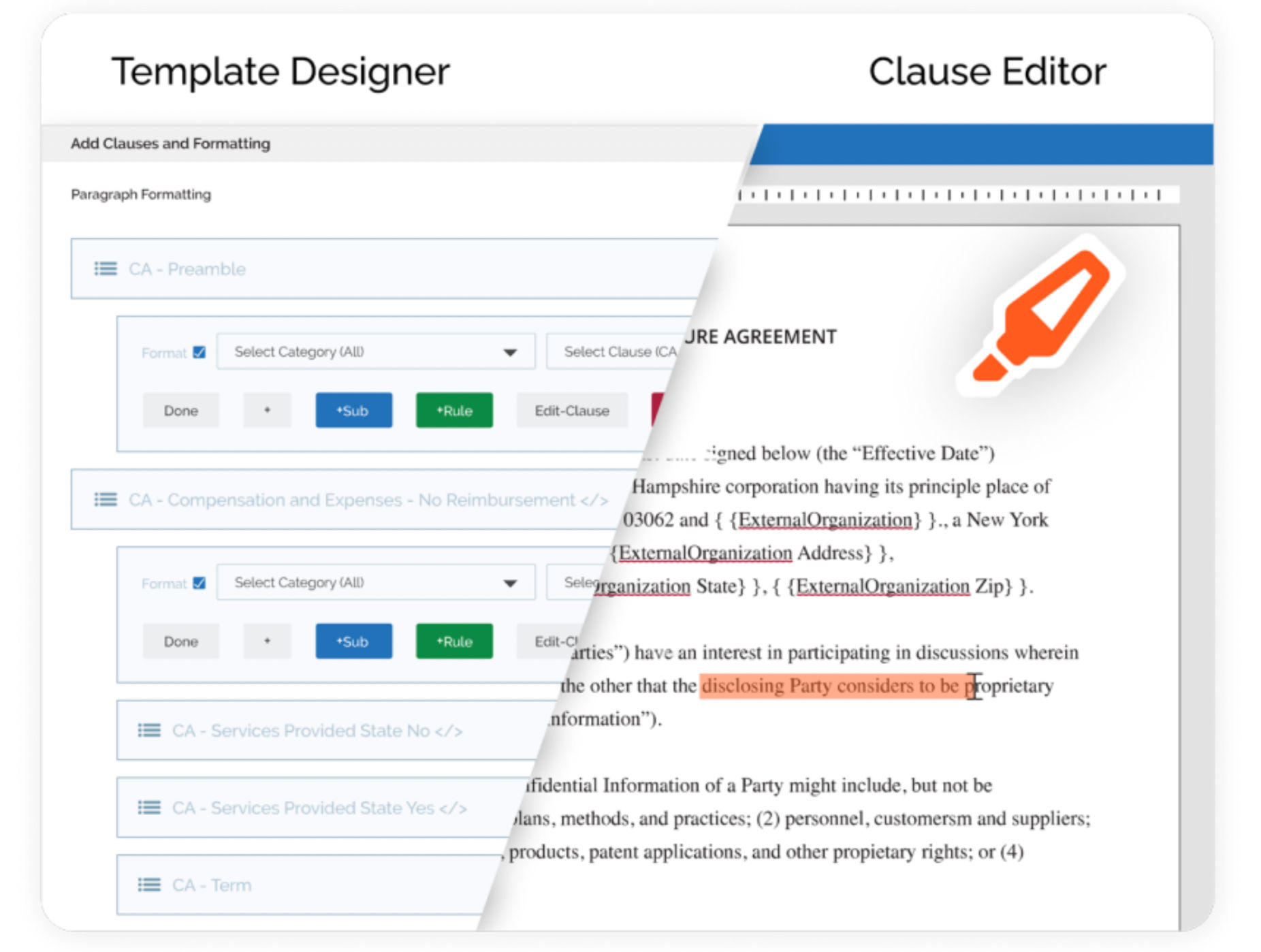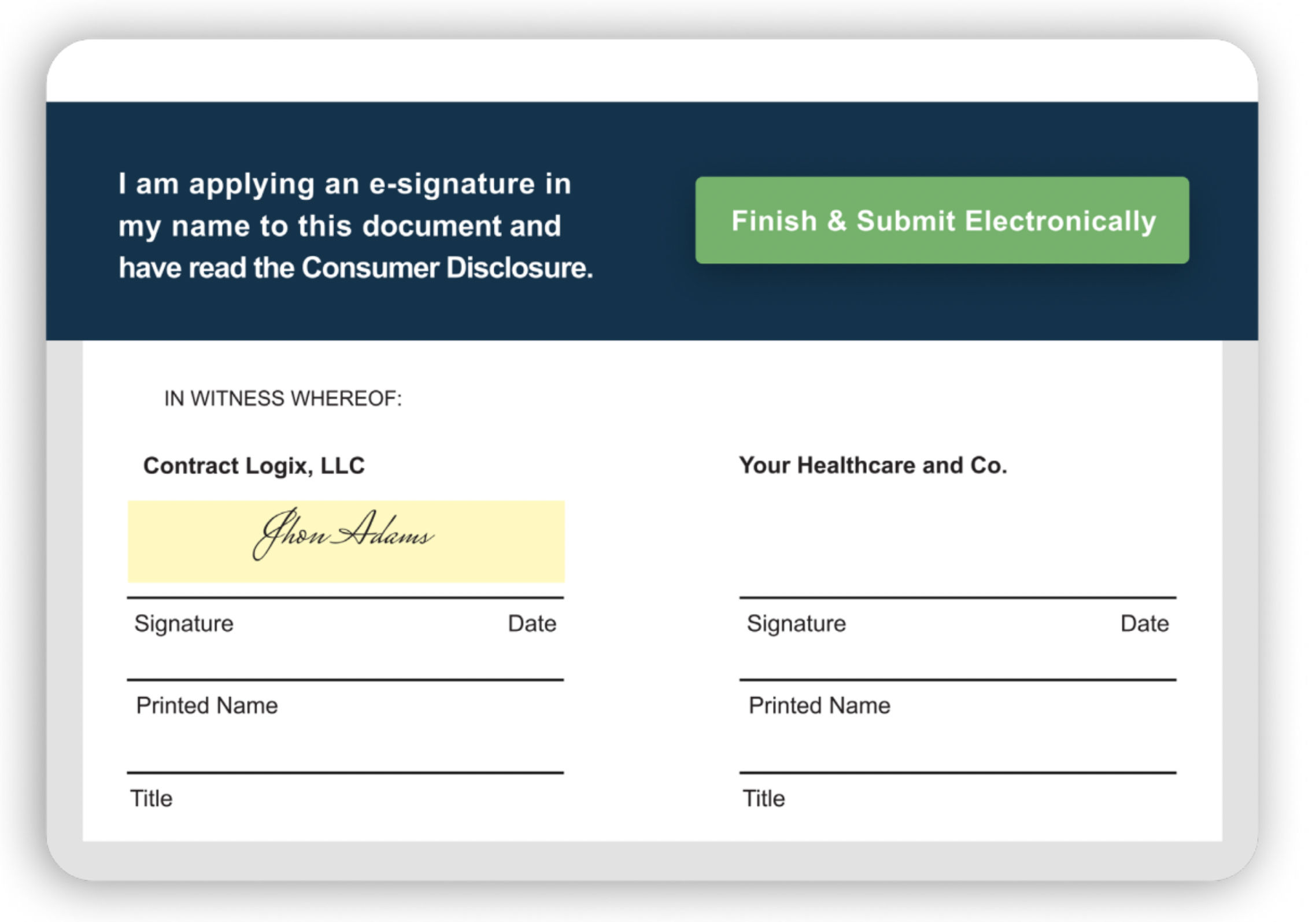The Dos and Don’ts for Optimizing Contract Management Software Workflows
June 3rd, 2024
Organizations thrive on efficient contract management, making it a critical business process. From the initial request to post-execution activities, optimizing each step of the contract management software workflow ensures informed decision-making and successful contract execution.
Leveraging contract lifecycle management (CLM) software streamlines this process, enhancing overall organizational efficiency and mitigates risk.
Quick Takeaways
- Efficiently handling contract requests, drafting, negotiations, and approvals ensures a strong foundation and reduces risk.
- Utilizing E-Signature accelerates the signing process, executing legally-binding contracts quickly and securely.
- Properly tracking obligations, auditing performance, and managing contract data ensures ongoing compliance and mitigates risk.
- Leveraging CLM software automates and standardizes the entire contract lifecycle, enhancing accuracy, efficiency, and strategic decision-making.
😉 PS: Learn the top strategies for optimizing your contract management software workflows here.
Understanding the Contract Lifecycle Phases
An optimized contract management workflow manages all 8 phases of the contract lifecycle, each crucial for seamless operations.

Here’s an overview of the 3 key stages of contract lifecycle management:
Stage 1. Pre-Execution
This stage includes all activities before the contract is signed: requesting the contract, gathering necessary details, authoring and drafting the document, negotiating terms, collaborating with stakeholders, and finalizing reviews and approvals.
Stage 2. Execution and Signatures
This stage involves the formal signing of the contract by authorized representatives of both parties, either through physical (wet) signatures or digital E-Signatures, making the contract legally binding.
Stage 3. Post-Execution
This stage covers activities after the contract is signed: managing and tracking obligations, conducting audits and reporting, and handling renewals, amendments, expirations, and terminations.
😉 Get a complete overview of the 8 phases of CLM here.
Pre-Execution
Phase 1: Request and Intake
Request and Intake is the initial phase where an authorized employee submits a contract request and gathers all necessary details.
Do:
- Use contract management software to automate and standardize the intake process, ensuring all required information is included.
- Gather detailed information such as counterparty details, deliverables, key terms, and conditions.
Don’t:
- Allow manual errors by using ad hoc entry methods.
- Overlook the importance of comprehensive and accurate intake information.
Why Is Request and Intake Important?
The request and intake phase lays the foundation for the contract. Insufficient information can lead to delays, misguided negotiations, and operational risk.
How Does CLM Software Improve Request and Intake?
CLM software automates the intake workflow, eliminating manual errors, and ensuring all necessary information is provided. It standardizes contract language and formatting, making the process faster, more efficient, and more accurate.
Phase 2: Authoring and Drafting

Authoring and Drafting involves writing the first draft of the contract, and incorporating input from various stakeholders.
Do:
- Utilize CLM software for standardized templates and clause libraries.
- Collaborate with stakeholders to refine the contract draft.
Don’t:
- Write contracts from scratch when pre-approved templates are available.
- Neglect to include all necessary terms and conditions.
Why Is Authoring and Drafting Important?
A well-drafted contract reflects the company’s position, ensures legal accuracy, and defines all terms and conditions clearly. It is crucial for successful negotiations and compliance.
How Does CLM Software Improve the Authoring and Drafting Process?
Contract lifecycle management software offers template libraries and pre-approved clauses, streamlining contract creation and more consistent. It reduces the risk of deviations from internal and regulatory standards while ensuring legal compliance.
Phase 3: Negotiation and Collaboration
Negotiation and Collaboration is when the contract draft is reviewed, edited, and negotiated by internal and counterparties to reach a final agreement.
Do:
- Use a contract management solution for efficient redlining and automatic version control.
- Facilitate streamlined collaboration by securely circulating digital contracts to all relevant stakeholders.
Don’t:
- Rely on manual processes that can delay negotiations.
- Skip internal reviews before sending the contract to counterparties.
Why Is Negotiation and Collaboration Important?
Internal review ensures contracts are error-free and meet organizational standards before reaching the counterparty, avoiding potential setbacks in negotiations.
How Does CLM Software Improve Negotiation and Collaboration?
CLM software streamlines the process by circulating digital contracts for review, automatically tracking revisions, and ensuring timely collaboration. It simplifies external negotiations, making the entire process faster and more efficient.
Phase 4: Reviews and Approvals
This phase occurs when the final draft of the contract is circulated for review and approval by all necessary internal and external stakeholders.
Do:
- Automate the review and approval process with contract management software.
- Ensure all necessary departments review and approve the contract.
Don’t:
- Allow delays by not tracking the review progress.
- Ignore the importance of a thorough legal review.
Why Are Reviews and Approvals Important?
A meticulous review and approval process minimizes mistakes and avoids surprises. It ensures the contract adheres to legal standards and internal guidelines.
How Does CLM Software Improve Reviews and Approvals?
Contract management software automates contract routing, ensuring the right individuals review the contract via workflows. It tracks all changes and approvals, creating a detailed audit trail and minimizing the risk of human error.
Execution and Signatures
Phase 5: Execution and Signatures

Next, the contract is signed by authorized representatives of both parties, making it legally binding.
Do:
- Utilize E-Signature capabilities for faster and secure contract execution.
- Ensure signatures are obtained from authorized personnel.
Don’t:
- Delay execution by using only wet signatures.
- Risk legal issues by not verifying the authenticity of signatures.
Why Are Execution and Signatures Important?
Executed contracts are legally binding. Delays in signing can affect deliverables and overall contract performance and stunt time to value. Ensuring authorized signatures is crucial for legal compliance.
How Does CLM Software Improve Execution and Signatures?
Built-in E-Signature capabilities within CLM software facilitates faster execution, reduces errors, and enhances security. The process is streamlined, making it compatible with remote and hybrid work environments.
Post-Execution
Phase 6: Managing Obligations and Commitments
This is the post-execution phase where all contractual obligations and deliverables are tracked and managed.
Do:
- Track deliverables and obligations with automated alerts.
- Monitor both your own and the counterparty’s commitments.
Don’t:
- Miss deadlines due to lack of visibility and tracking.
- Ignore penalties for unmet obligations.
Why Is Managing Obligations and Commitments Important?
Contractual obligations are legally binding. Meeting deadlines and fulfilling commitments is crucial to avoid legal and financial penalties.
How Does CLM Software Improve Obligations and Commitment Management?
Contract management software automates deliverables tracking, sending alerts to appropriate staff well before deadlines. It ensures visibility and accountability, reducing the risk of missed obligations.
Phase 7: Auditing and Reporting
Auditing and Reporting involves generating reports and conducting audits to ensure compliance and assess contract performance.
Do:
- Generate detailed reports and perform regular audits using CLM software.
- Use contract data to inform strategic decisions.
Don’t:
- Overlook the value of data-rich reporting for compliance and risk mitigation.
- Depend solely on manual auditing processes.
Why Is Auditing and Reporting Important?
Extracting valuable insights from contract data helps improve business operations and decision-making. Detailed reporting maximizes contract value and mitigates risk.
How Does CLM Software Improve Auditing and Reporting?
CLM software offers robust reporting and analysis tools, providing real-time data and insights. It integrates with other business systems, enhancing overall visibility and compliance automatically.
Phase 8: Renewals, Amendments, Expirations, and Terminations
The last phase manages the end-of-contract options, including renewals, amendments, expirations, and terminations.
Do:
- Set alerts for upcoming contract expirations well in advance.
- Evaluate contract performance before deciding on renewals or terminations.
Don’t:
- Allow contracts to auto-renew without proper review.
- Wait until the last minute to renegotiate terms or amend contracts.
Why Is Managing Renewals, Amendments, Expirations, and Terminations Important?
Proactively managing contract end dates ensures strategic decisions are made in a timely manner, avoiding unwanted auto-renewals or lapses in service.
How Does CLM Software Improve End-of-Contract Management?
Contract management software alerts users well before contract expirations, providing ample time for evaluation and negotiation. It supports strategic decision-making through detailed reporting and analysis.
😉 For more CLM best practices, get The 10 Do’s and Don’ts of Contract Lifecycle Management here.
The Path to Streamlined Contract Management
Optimizing contract management software workflows is essential for organizational efficiency and compliance. By following these dos and don’ts, and leveraging the capabilities of CLM software, businesses can streamline their contract processes, mitigate risk, and drive profitability.
Contract Logix streamlines the entire contract management process, from initial request to post-execution activities, through advanced automation and standardization. By leveraging digital tools and automated workflows, businesses can reduce manual errors, ensure compliance, and accelerate the contract lifecycle. With real-time insights and robust reporting features, Contract Logix enables organizations to make informed, strategic decisions and improve overall efficiency.
Ready to see how Contract Logix can enhance your contract management? Contact our team to discuss your specific needs or request a personalized demo to experience our platform in action.
Navigate CLM Success With Contract Logix
Download our Data Extraction Product Brief to learn how you can begin to navigate CLM success by automating the hard work using artificial intelligence with one of the best Contract Management Software’s on the market today


